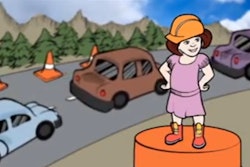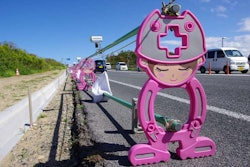 A snapshot of the I-5 Columbia River Crossing toll booths, taken in March 1965, shows the surrounding community, including pre-eruption Mount St. Helens. (Photo: WSDOT)
A snapshot of the I-5 Columbia River Crossing toll booths, taken in March 1965, shows the surrounding community, including pre-eruption Mount St. Helens. (Photo: WSDOT)The highway, that venerable American institution–that core value, that industry and community building institution–is under assault again.
Better Institutions, a blog about transportation and urban planning policy, joins a chorus of blogs addressing what it calls, “The self-defeating nature of highway construction and expansion,” and specifically, “Lost in the discussions of induced demand (focused on the highway itself) and community displacement and segregation (focused on local residents and businesses) is the intersection of these two issues, local traffic.”
“The problem here is obvious: unless 100% of the new highway users are bypass traffic — none of them using the highway to get into the city itself –local roads have to deal with a huge influx of additional vehicles. Many of those vehicles aren’t bypass traffic, of course, so local streets (and their residents) are burdened with their presence and the congestion they bring.”
“This illustrates two important facts: first, that increasing capacity doesn’t actually improve the traffic situation on the highway; second, that it makes local traffic worse.”
The problem to begin with is a need to move more people. Highway expansion is one way to do it. More capacity carries more people. Yes, that is a basic and simple approach because–as this blogger and others point out–more lane miles have consequential effects in the communities they pass through and draw from. But those consequences can be of great value to communities.
There is an increasingly loud clamor that all freeway expansion is a bad thing. The public hears it because the web delivers it so efficiently. Much of it comes from anonymous or unqualified voices, but much of it comes from people interested, involved, recognized and listened to in their communities. (The blogger in this case is Shane Phillips, is a research scientist.)
That is troubling because if “down with highways” becomes some sort of common wisdom, road building is going to have an even tougher time finding funding. And if that happens, road and bridge maintenance and repair will be equally short of funds and deterioration, already so well under way, will increase at a faster pace. Actually, since we are at that point now, I should probably say it will just get worse.
Some road expansion projects will not be the best solution, but unless we are careful, the public perception of added capacity may become so negative that the result will be that almost no expansion projects–even those that are clearly the superior solution–will get political backing.
You will have recognized by now that I am atop one of my favorite soapboxes. There is an oversupply of online sites dedicated to “transportation solutions” that essentially oppose all road expansion projects. I’m all for bikes and pedestrians and tranquil, safe walking neighborhoods and inner cities, but this is not a zero-sum game unless we let it be. We need (spoiler alert: popular buzzword coming) a matrix of transportation solutions to best serve the public.
Make sure your politicians and local journalists get your take on this debate. Neither politicians nor journalists are known for being fair and balanced anymore unless there’s something in it for them. Make sure they have your take, one that counters constructive argument with constructive argument.
Our industry does not simply stand on the past or dismiss changes in the way Americans live and what they value. We build–over time because these projects are not short-term–to serve the communities of today and tomorrow with today and tomorrow’s roadways. And we need to get that idea across.
Oh, and note in the aforementioned blog that there is a very old photo which elicited this comment:
“I don’t know which is more jarring to the modern observer: Seeing Mount St. Helens, pre-1980 eruption, or seeing a toll plaza on I-5 …”
Toll plazas on an Interstate?












